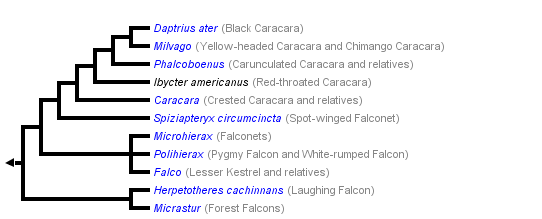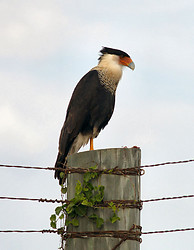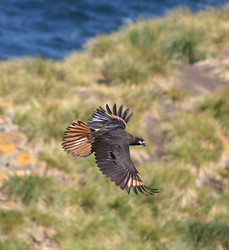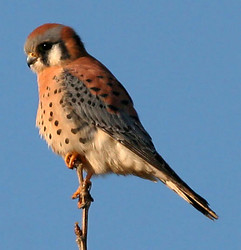Falconiformes
Falconidae
Falcons
David P. Mindell and John Harshman


This tree diagram shows the relationships between several groups of organisms.
The root of the current tree connects the organisms featured in this tree to their containing group and the rest of the Tree of Life. The basal branching point in the tree represents the ancestor of the other groups in the tree. This ancestor diversified over time into several descendent subgroups, which are represented as internal nodes and terminal taxa to the right.

You can click on the root to travel down the Tree of Life all the way to the root of all Life, and you can click on the names of descendent subgroups to travel up the Tree of Life all the way to individual species.
For more information on ToL tree formatting, please see Interpreting the Tree or Classification. To learn more about phylogenetic trees, please visit our Phylogenetic Biology pages.
close boxDiscussion of Phylogenetic Relationships
Falconiformes traditionally includes all the diurnal raptors: Accipitridae (hawks, eagles, kites), Pandionidae (osprey), Cathartidae (New World vultures), and Sagittariidae (secretary bird), but all these have been removed to a separate order, Accipitriformes, leaving Falconidae as the only family in the order.
References
Brown, L. and D. Amadon. 1968. Eagles, Hawks, and Falcons of the World. Middlesex: Country Life Books.
del Hoyo, J., A. Elliot, and J. Sargatal (eds). 1994. Handbook of the Birds of the World, Vol. 2. Barcelona, Spain: Lynx Ediciones.
Ferguson-Lees, J. and D. A. Christie. 2001. Raptors of the World. London, UK: Christopher Helm.
Griffiths, C. S. 1994. Monophyly of the Falconiformes based on syringeal morphology. Auk 111:787-805.
Griffiths, C. S.. 1999. Phylogeny of the Falconidae inferred from molecular and morphological data. Auk 116:116-130.
Griffiths, C. S., G. F. Barrowclough, J. G. Groth, and L. Mertz. 2004. Phylogeny of the Falconidae (Aves): a comparison of the efficacy of morphological, mitochondrial, and nuclear data. Mol. Phylogenet. Evol. 32:101-109.
Olson, S. L. 1976. The affinities of the falconid genus Spiziapteryx. Auk 91:633-635.
Seibold, I., A. J. Helbig, and M. Wink. 1993. Molecular systematics of falcons (family Falconidae), Naturwissenschaften 80:87-90.
Wink, M. and H. Sauer-Gurth. 2004. Phylogenetic relationships in diurnal raptors based on nucleotide sequences of mitochondrial and nuclear marker genes. In: Chancellor, R. D.; Meyburg, B.-U. (eds), Raptors Worldwide. Budapest/Berlin: MME/WWGBP, pp. 483–498.
Title Illustrations

| Location | Laguna Vista, Texas |
|---|---|
| Specimen Condition | Live Specimen |
| Source | Crested Caracara |
| Source Collection | Flickr |
| Image Use |
 This media file is licensed under the Creative Commons Attribution-NonCommercial License - Version 2.0. This media file is licensed under the Creative Commons Attribution-NonCommercial License - Version 2.0.
|
| Copyright | © 2005 Michael Martin |
| Scientific Name | Phalcoboenus australis |
|---|---|
| Specimen Condition | Live Specimen |
| Source | Caracara |
| Source Collection | Flickr |
| Image Use |
 This media file is licensed under the Creative Commons Attribution-NonCommercial-ShareAlike License - Version 2.0. This media file is licensed under the Creative Commons Attribution-NonCommercial-ShareAlike License - Version 2.0.
|
| Copyright | © Morgan |
| Scientific Name | Falco sparverius |
|---|---|
| Comments | American Kestrel |
| Specimen Condition | Live Specimen |
| Sex | Male |
| Source | American Kestrel (Male) |
| Source Collection | Flickr |
| Image Use |
 This media file is licensed under the Creative Commons Attribution-NonCommercial-ShareAlike License - Version 2.0. This media file is licensed under the Creative Commons Attribution-NonCommercial-ShareAlike License - Version 2.0.
|
| Copyright | © 2006 Ashok Khosla |
About This Page
David P. Mindell

California Academy of Sciences, San Francisco, California, USA
Correspondence regarding this page should be directed to David P. Mindell at and John Harshman at
Page copyright © 2007 David P. Mindell and
 Page: Tree of Life
Falconiformes. Falconidae. Falcons.
Authored by
David P. Mindell and John Harshman.
The TEXT of this page is licensed under the
Creative Commons Attribution-NonCommercial License - Version 3.0. Note that images and other media
featured on this page are each governed by their own license, and they may or may not be available
for reuse. Click on an image or a media link to access the media data window, which provides the
relevant licensing information. For the general terms and conditions of ToL material reuse and
redistribution, please see the Tree of Life Copyright
Policies.
Page: Tree of Life
Falconiformes. Falconidae. Falcons.
Authored by
David P. Mindell and John Harshman.
The TEXT of this page is licensed under the
Creative Commons Attribution-NonCommercial License - Version 3.0. Note that images and other media
featured on this page are each governed by their own license, and they may or may not be available
for reuse. Click on an image or a media link to access the media data window, which provides the
relevant licensing information. For the general terms and conditions of ToL material reuse and
redistribution, please see the Tree of Life Copyright
Policies.
- First online 24 May 2006
- Content changed 27 June 2008
Citing this page:
Mindell, David P. and John Harshman. 2008. Falconiformes. Falconidae. Falcons. Version 27 June 2008 (under construction). http://tolweb.org/Falconidae/26379/2008.06.27 in The Tree of Life Web Project, http://tolweb.org/











 Go to quick links
Go to quick search
Go to navigation for this section of the ToL site
Go to detailed links for the ToL site
Go to quick links
Go to quick search
Go to navigation for this section of the ToL site
Go to detailed links for the ToL site